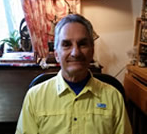University of Redlands Emergency Alert System
Alert Received: . For more information, visit: https://www.redlands.edu/alert/
University of Redlands
Professional Bio:
 Dr. Gary Scott has a Masters in Biology, a minor in mathematics, and Doctorate of Education from the Graduate School of Education & Information Studies at UCLA. He was a secondary science and mathematics teacher for over 23 years in the Los Angeles Unified School District (LAUSD). He became a secondary mathematics and science advisor for LAUSD's Urban Systemic Initiative (USI) and Urban Systemic Program (USP). As a classroom teacher and advisor he has created and presented numerous in-service workshops to teachers to improve science and mathematics teaching including developing two-week summer institutes for teachers participating in the USI and USP. He helped in the development of a Coordinated Science Program for LAUSD as part of the statewide Scope, Sequence and Coordination (SS&C) Project. In conjunction with other LAUSD teachers in the SS&C Project he wrote district-wide Coordinated Science course guidelines and descriptions that received University of California approval for laboratory science. He has participated in numerous NSF-funded teacher enhancement projects, including serving as co-principal investigator on the NSF-funded IMMEX project at the UCLA School of Medicine.
Dr. Gary Scott has a Masters in Biology, a minor in mathematics, and Doctorate of Education from the Graduate School of Education & Information Studies at UCLA. He was a secondary science and mathematics teacher for over 23 years in the Los Angeles Unified School District (LAUSD). He became a secondary mathematics and science advisor for LAUSD's Urban Systemic Initiative (USI) and Urban Systemic Program (USP). As a classroom teacher and advisor he has created and presented numerous in-service workshops to teachers to improve science and mathematics teaching including developing two-week summer institutes for teachers participating in the USI and USP. He helped in the development of a Coordinated Science Program for LAUSD as part of the statewide Scope, Sequence and Coordination (SS&C) Project. In conjunction with other LAUSD teachers in the SS&C Project he wrote district-wide Coordinated Science course guidelines and descriptions that received University of California approval for laboratory science. He has participated in numerous NSF-funded teacher enhancement projects, including serving as co-principal investigator on the NSF-funded IMMEX project at the UCLA School of Medicine.
He served as a mathematics and science coordinator for Local District 7 in LAUSD and developed an integrated mathematics and science intersession program for middle school students. He left LAUSD to become an assistant professor of clinical education in the Rossier School of Education at USC. Currently he is a Visiting Professor of Education at the University of Redlands.
His research interests are centered on applying cultural-historical theory and Reuven Feuerstein’s theory of Structural Cognitive Modifiability to the teaching and learning of mathematics and science. Based on these theoretical foundations he has developed and implemented many classroom projects and teacher professional development opportunities. Currently, he is working with local elementary schools to implement the Inventatorium. The Inventatorium addresses the need for underrepresented minority youth to have opportunities for effective afterschool and curricular STEM focused educational programs. The Inventatorium integrates big ideas from science, technology, engineering, and mathematics in a project-based learning approach that is innovative and inspirational for students and can be implemented in formal as well as informal learning environments. Students are encouraged to invent, design, and build structures, mechanisms, and devices based on their interests and creativity. These cognitively demanding and interesting tasks, problems, design challenges, and mediation strategies promote conceptual understanding of important mathematical and scientific ideas that build emotional connections to knowledge of mathematics and science concepts. In short, the Inventatorium’s activities invoke creativity, imagery and emotion that are often absent from traditional STEM teaching and curricula in K-12 educational settings.
Project Summary:
This spatial integration proposal will better prepare prospective teachers in the School of Education to implement spatially-based tasks, problems, and engineering design challenges. In turn, these activities will help their students improve innate capacities for spatial thinking. I will assign these spatially-based tasks, problems, and projects during face-to-face-time. Text and article readings that describe the underlying concepts for these activities will be assigned for homework
Spatial integration is based on the following logic derived from emerging research on the role that spatial reasoning plays in supporting STEM success: (1) students with greater spatial reasoning abilities perform better in high school and college-level STEM courses, even when controlling for verbal and mathematical abilities; (2) spatial reasoning abilities are an important component of STEM thinking skills that lead to success in higher-level STEM courses; (3) STEM courses serve as gatekeepers for students entering many professional fields; and (4) spatial reasoning abilities may be improved through training and educational interventions. Applying research on spatial thinking interventions that have been shown to be effective with middle school and college-age students, spatial STEM integration will build prospective teachers capacity to (1) choose or create optimal external representations and use novel external representations productively in the classroom; (2) implement spatial thinking experiences for their students that effectively and efficiently support student competency, motivation and persistence.
This project will contribute to the University of Redlands goal of infusing spatial thinking across the curriculum in the following ways: